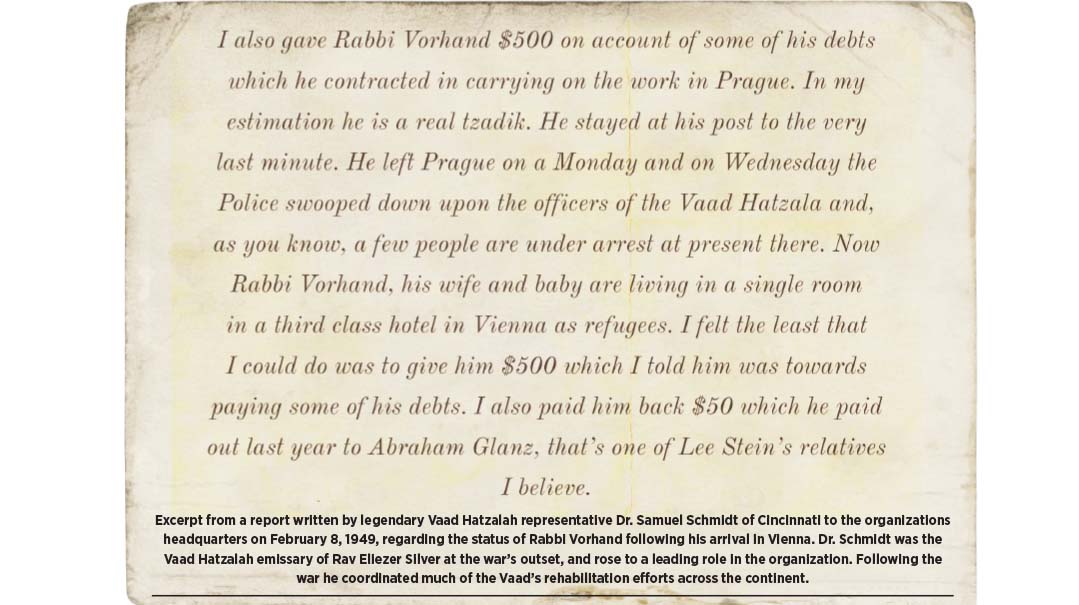V Is for (Rabbi) Vorhand
| December 7, 2021He possessed an ability to “get things done”

With the guns of war finally silenced in Europe in May 1945, Jewish survivors began rebuilding from the smoldering ruins of the Holocaust. As Stalin solidified control over the Eastern bloc, streams of refugees headed west. Several hundred thousand Jewish refugees from the Soviet Union, Poland, Romania, and Hungary fled the descending Iron Curtain by way of Prague, Czechoslovakia, which became a postwar hub of rescue activity.
Coordinating much of the relief work was a dynamic rabbi named Rabbi Zev Tzvi (Victor) Vorhand. He possessed an ability to “get things done” — obtaining food, clothing, and shelter for refugees, temporary transit documents, and most importantly, visas to final destination countries. In his position as Prague's chief rabbi, he developed key relationships with important diplomats, including Laurence Steinhardt, the Jewish US ambassador to Czechoslovakia; and Czech foreign minister Jan Masaryk, among others.
Stemming from an illustrious rabbinical family, he enjoyed a close relationship with his grandfather Rav Moshe Vorhand, the Makover Rav, while his father Rav Mordechai was the rabbi of Nitra, Slovakia. His rescue work commenced before the war’s outbreak, while he was still a student at the Pressburg yeshivah, with an attempt to charter a steamer to transport refugees down the Danube to the Black Sea and then to safety in Palestine. The Belzer Rebbe, Rav Aharon Rokeach, blessed his efforts by declaring, “Di bist a baal chein. Di vest nosei chein zein. Lech v'hoshata.” (“You are someone who possesses chein. You will find favor with others. Go and be successful.”)
But his rescue efforts really took off with the postwar refugee influx in Prague. Rabbi Vorhand represented the Vaad Hatzalah, and was key to the efforts of Rabbi Solomon Schonfeld’s London-based Chief Rabbi’s Religious Emergency Council, Agudath Israel, the Joint, and the Zionist Bericha movement. His efforts were aimed at assisting the maximum number of Jews possible, regardless of background or affiliation.
His primary focus was to obtain non-quota visas to the United States and other countries. While it is unclear just how many visas he managed to procure, sources indicate that it likely was many thousands. Another of his postwar projects was the Vaad Hatzalah Rescue Children initiative. As the Vaad’s representative in Prague, Rabbi Vorhand would go from house to house searching for Jewish children, often turning to priests and paying ransom to return orphaned children to Klas Yisrael.
By 1949 Rabbi Vorhand escaped from the Communists to Vienna, where he continued his hatzalah activities. A year later he arrived in New York, deeply in debt as a result of his having doled out large sums for relief work. With the assistance of his co-hatzalah activists he was able to settle his affairs, and establish the Heichal Moshe shul on Manhattan’s Upper West Side. Known as “Rabbi Vorhand’s Shul,” it became a center of chesed and Jewish education through the ensuing decades.
Unconventional Tactics
One of the tactics used by Rabbi Vorhand and his fellow activists for obtaining visas was to promote a fictitious “Agudah Convention” in the US, to which refugees were invited as delegates from their former countries. The ruse succeeded, and more than 300 visas were granted. The story of how those temporary visas were turned into permanent ones is told at length in the biography of Irving Bunim, A Fire in His Soul.
The Rebbe Remembers
During the post-Stalinist thaw of the 1950s, there was a brief window of opportunity for rescue from the Soviet Union. Should Rabbi Vorhand utilize his political connections to rescue Jews once again? He presented the question to Rav Areleh Belzer, who repeated his exact words of 17 years earlier, although there had been no interaction between them in the interim — “Ich hub dir doch gezugt [I already told you] — di bist a baal chein. Di vest nosei chein zein. Lech v'hoshata!”
The yahrtzeit of Rabbi Zev Tzvi Vorhand is this Wednesday, 4 Teves.
(Originally featured in Mishpacha, Issue 889)
Oops! We could not locate your form.





